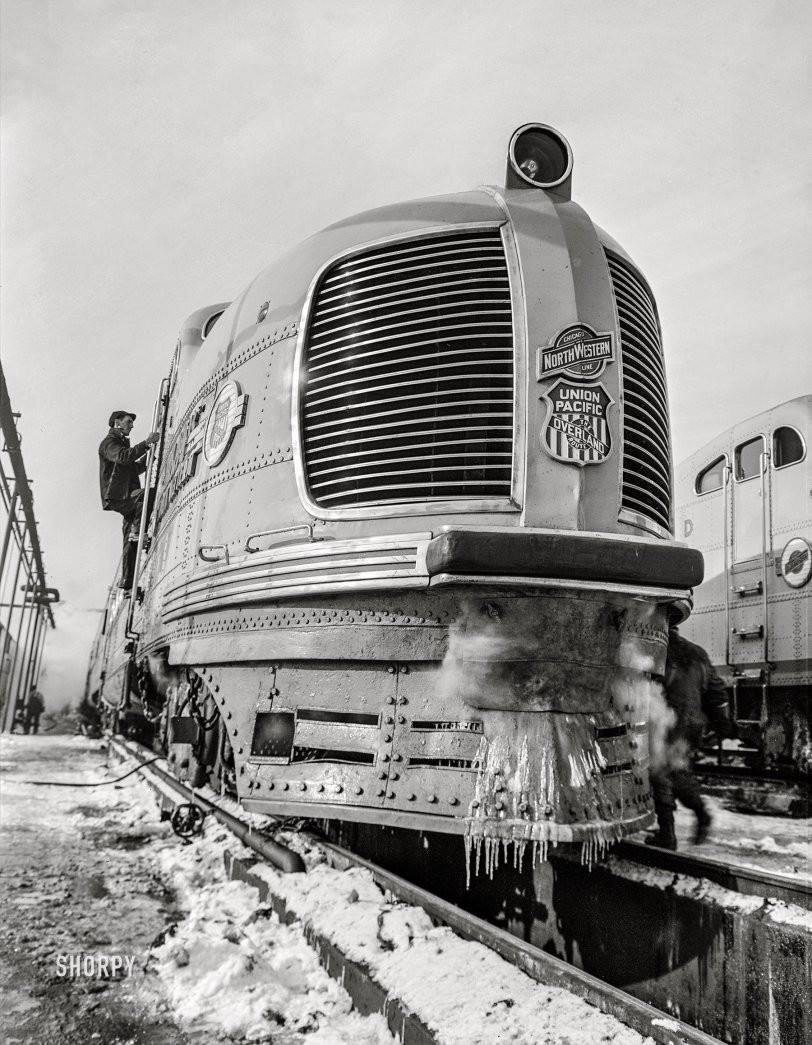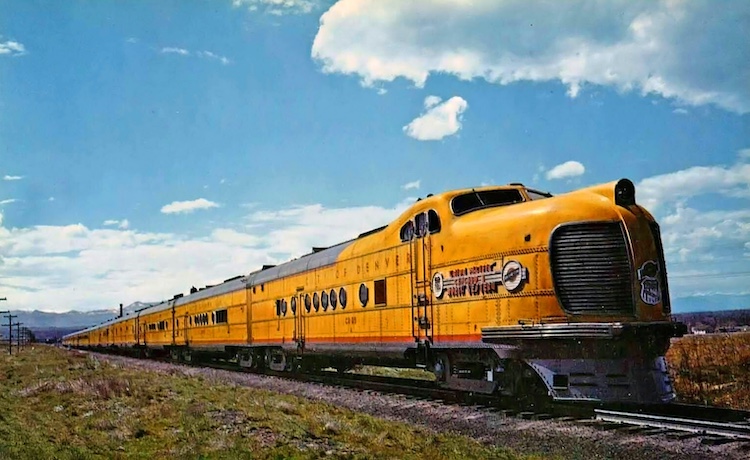


Framed or unframed, desk size to sofa size, printed by us in Arizona and Alabama since 2007. Explore now.
Shorpy is funded by you. Patreon contributors get an ad-free experience.
Learn more.

- What a headache!
- Baldwin 62303
- Baldwin VO-1000
- Cold
- No expense spared
- Tough Guys
- Lost in Toyland
- And without gloves
- If I were a blindfolded time traveler
- Smoke Consumer Also Cooks
- Oh that stove!
- Possibly still there?
- What?!?
- $100 Reward
- Freeze Frame
- Texas Flyer wanted
- Just a Year Too Soon
- WWII -- Replacing men with women at the railroad crossing.
- Yes, Icing
- You kids drive me nuts!
- NOT An Easy Job
- I wonder
- Just add window boxes
- Icing Platform?
- Indiana Harbor Belt abides
- Freezing haze
- Corrections (for those who care)
- C&NW at Nelson
- Fallen Flags
- A dangerous job made worse
Print Emporium
Hybrid EV: 1942

December 1942. "Chicago, Illinois. One of the Chicago and North Western Railroad streamliner diesel electric locomotives. These trains are operated jointly with the Union Pacific Railroad to the West Coast." Acetate negative by Jack Delano, Office of War Information. View full size.
Corrections (for those who care)
This locomotive is a Pullman-Standard M-10005 or M-10006, produced in 1936 -- a descendant of the "original" M-10000 from 1934, which was already retired a year when this photo was taken. These were predecessors of the famous EMC/EMD "E" series locomotives produced by EMD starting in 1937.
Additionally, the icicle "beard" was caused by leaking steam from the steam train line -- steam was used to heat (and cool in summer for coaches that had steam-ejector air conditioning installed) the passenger coaches, and was produced by steam boilers on the locomotive. Steam was used on all conventional passenger equipment until the late 1970s when electrical head-end-power (HEP) came into vogue.
About that runny nose.
Water is never permitted in a trains air hose. A frozen brake line is a train wreck looking for a place to happen.
Passenger engines such as this one have (had) a steam generator on board to supply a steam pipe to the entire train for heating, air conditioning, cooking, etc. The ice on the pilot would be condensate from this steam line.
Steam Heat
Passenger cars of the past used steam for heating and, in some cases, for air conditioning too. Steam locomotives had plenty, but diesel electric locomotives needed diesel oil fired auxiliary boilers. The steam is transmitted from locomotive to cars via metal pipes and couplings. In freezing weather, it seemed one could always see whisps of steam here and there - perhaps the valve beneath the pilot (steel plate above the rails) was slightly cracked open to prevent freezing. Once can see minor damage to the pilot - perhaps the locomotive encountered a vehicle somewhere at a crossing.
Only a handful of these machines were built before larger and more powerful locomotives became available. I recall reading that one of these locomotives struck a skunk which splattered over the area where we see the frozen steam. The large, automobile-like grilles, supposedly brought the odor into the cab making things stinky for the crew.
Not an E-unit. It's an M-10000!
I think that the "runny nose" comes from water in the air hoses. (Just a guess!!)
Achoo-choo!
It looks like its nose is running! I love that streamlined look, though. I'll bet it's sporting that striking Union Pacific armour yellow and gray paint scheme, too!
I take it back
The E-series didn't have the radiator. Lionel offered two streamliners, the M10000 and this thing. I can't find pictures of this thing that also give the model number.
EMD E6
It looks like the EMD E-series, guessing E6, built from 1938 to 1942.
Chug and play
Shorpy is certainly correct - but then almost all (North American) "diesels" are such: a diesel engine drives a generator that powers the traction motors. But the U.P. was strictly an amateur about combining powering methods

The SBB lok is still around - ! - but converted back to free-range capabilities.
Not hybrid or EV.
Locomotives are diesel-electric, not hybrid. The electric part is the method of power transmission between the engine and wheels because they have a 250-950rpm operating range. A gearbox would be too large and complex to be practical, especially when synchronizing multiple units. They don't charge or operate on batteries (except some at low yard speeds for shuttling).
[You're thinking about this much too narrowly. Hybrid: "Of mixed character; a thing made by combining two different elements." - Dave]

























On Shorpy:
Today’s Top 5